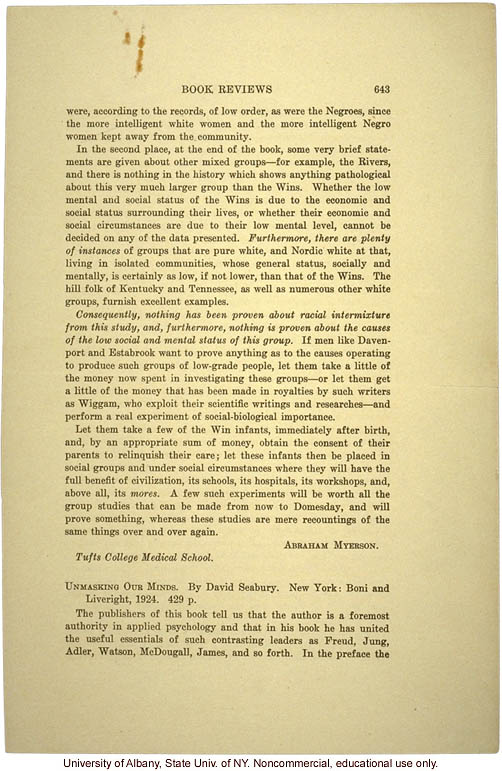ID# 1333: |
Critcal review of Mongrel Virginians, by Abraham Myerson, Mental Hygiene | |||
Date: |
Circa 1926 |
|||
Source: |
University of Albany, SUNY, Estabrook, SPE,XMS 80.9 Bx 1 folder1-36 | |||

 |
|
| |||||||||||||||||

Book Reviews 643 were, according to the records, of low order, as were the Negroes, since the more intelligent white women and the more intelligent Negro women kept away from the community. In the second place, at the end of the book, some very brief statements are given about other mixed groups - for example, the Rivers, and there is nothing in the history which shows anything pathological about this very much larger group than the Wins. Whether the low mental and social status of the Wins is due to the economic and social status surrounding their lives, or whether their economic and social circumstances are due to their low mental level, cannot be decided on any of the data presented. [begin italics] Furthermore, there are plenty of instances[end italics] of groups that are pure white, and Nordic white at that, living in isolated communities, whose general status, socially and mentally, is certainly as low, if not lower, that that of the Wins. The hill folk of Kentucky and Tennessee, as well as numerous other white groups, furnish excellent examples. [begin italics] Consequently, nothing has been proven about racial intermixture from this study, and, furthermore, nothing is proven about the causes of the low social and mental status of this group. [end italics] If men like Davenport and Estabrook want to prove anything as to the causes operating to produce such groups of low-grade people, let them take a little of the money now spent in investigating these groups - or let them get a little of the money that has been made in royalties by such writers as Wiggam, who exploit their scientific writings and researches - and perform a real experiment of social-biological importance. Let them take a few of the Win infants, immediately after birth, and, by an appropriate sum of money, obtain the consent of their parents to relinquish their care; let these infants then be placed in social groups and under social circumstances where they will have the full benefit of civilization, its schools, its hospitals, its workshops, and, above all, its [begin italics]mores[end italics]. A few such experiments will be worth all the group studies that can be made from now to Doomsday, and will prove something, whereas these studies are mere recountings of the same things over and over again. Abraham Myerson. Tufts College Medical School. Unmasking Our Minds. By David Seabury. New York: Boni and Liveright, 1924. 429 p. The publishers of this book tell us that the author is a foremost authority in applied psychology and that in his book he has united the useful essentials of such contrasting leaders as Freud, Jung, Adler, Watson, McDougall, James, and so forth. In the preface the [end]